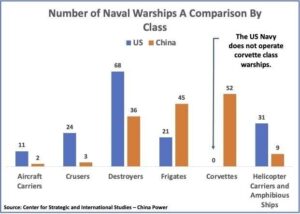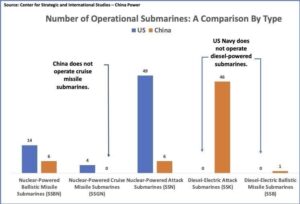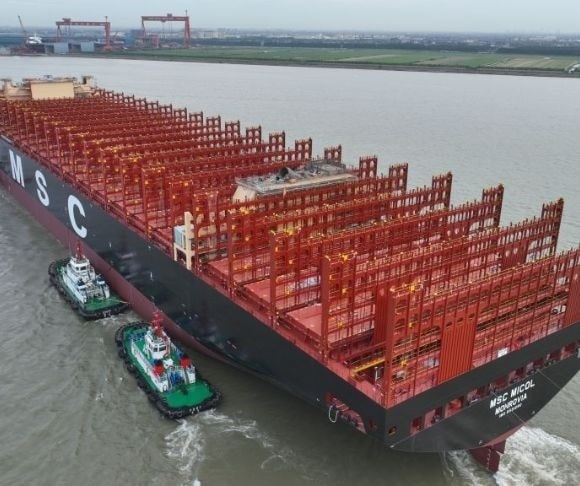As the People’s Republic of China (PRC) grows its defense spending, making readiness comparisons between the US and PRC military is always tempting. A recently published report on Chinese shipbuilding capability should be alarming. But does it spell a significant gap in capacity to prevail in a combat engagement at sea? Being able to build ships at a high rate does not necessarily equate to combat advantage. Additionally, the PRC total includes commercial shipbuilding as well as People’s Liberation Army Navy (PLAN) naval warship production. Still, the potential PLAN production can be considered formidable.
US Shipbuilding Gap With China
The War Zone published an unclassified Office of Naval Intelligence briefing chart in early July showing a PRC shipbuilding advantage over the United States of 200 times in terms of gross tonnage. The immense disparity got people’s attention. As Joseph Trevithick points out in The War Zone article:
“The most eye-catching component of the slide (Office of Naval Intelligence Chart) is a depiction of the relative Chinese and US shipbuilding capacity expressed in terms of gross tonnage. The graphic shows that China’s shipyards have a capacity of around 23,250,000 million tons versus less than 100,000 tons in the United States. That is at least an astonishing 232 times greater than the United States.”
It is no secret the PLAN has an advantage in the number of naval combatant ships, having surpassed the United States in 2020 with a total of 355 compared to our 296. But the count of maritime warships does not tell an accurate story of the ability to engage and survive an enemy at sea. Neither is tonnage a defining metric for comparing combatant power. “Bigger may or may not be better. Tonnage, then, is more a measure of maritime industrial potential than of the fleet’s combat strength in being,” James Holmes, a 19FortyFive contributing editor, wrote in a Real Clear Defense analysis “China’s Shipbuilding Capability: A Threat to the US Navy?” Other factors weigh in the analysis of naval warfare capability. The the number of naval vessels may give way to larger, more capable, and technically superior ships. “Larger hulls can carry more ammunition, fuel, and stores. Greater volume translates into the ability to stay at sea for longer intervals while dishing out more firepower,” Holmes observed. The accompanying charts compare the commissioned vessels described in the Center for Strategic and International Studies (CSIS) China Power Project.
 Though China has more in total, the graphic reflects actual commissioned blue water combat vessels capable of engaging an adversary; the numbers as of 2021 show almost parity between the PLAN and the US Navy. However, quantity alone does not take into consideration the sheer sea power of the 11 US aircraft carriers compared with the PLAN’s two and one yet to be commissioned. The United States has a significant advantage in cruisers and destroyers, while the PLAN has larger numbers in smaller, less capable frigates and corvette-class vessels. Furthermore, the United States has a three-to-one superiority in amphibious operations class of warfighting ships.
Though China has more in total, the graphic reflects actual commissioned blue water combat vessels capable of engaging an adversary; the numbers as of 2021 show almost parity between the PLAN and the US Navy. However, quantity alone does not take into consideration the sheer sea power of the 11 US aircraft carriers compared with the PLAN’s two and one yet to be commissioned. The United States has a significant advantage in cruisers and destroyers, while the PLAN has larger numbers in smaller, less capable frigates and corvette-class vessels. Furthermore, the United States has a three-to-one superiority in amphibious operations class of warfighting ships.
Rounding out the comparison, the United States has a significant advantage in nuclear-powered ballistic missile submarines and nuclear-powered attack submarines. China has a comparable number of attack submarines, but they are mostly diesel-electric and less capable overall, having to surface frequently to charge batteries.
 US Navy Way Behind China in Rate of Shipbuilding
US Navy Way Behind China in Rate of Shipbuilding
These numbers are not static: China is engaged in a rapid shipbuilding program. “The PLAN’s overall battle force is expected to grow to 400 ships by 2025 and 440 ships by 2030. Much of this growth will be in major surface combatants,” the US Department of Defense annual report Military and Security Developments Involving the People’s Republic of China 2022 estimates. Though the strategy behind the PLAN’s naval build-up is unclear, the Congressional Research Service, in a May report, posted that as much as a global blue water navy may be the ultimate intent, “China wants its navy to be capable of acting as part of an anti-access/area-denial (A2/AD) force — a force that can deter US intervention in a conflict in China’s near-seas region over Taiwan.” This has been a goal of the PRC, and “China has slowly but methodically created an A2/AD capability in the South China Sea,” Liberty Nation reported in March.
Increasing the number of ships the United States can produce each year is an industrial base challenge for the Navy and American shipyards. The capability to successfully fight naval battles depends on the Navy’s ability to achieve an affordable balance of fleet size, technological advantage, and firepower. China is not backing away.




